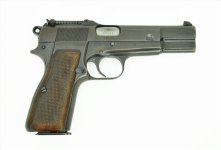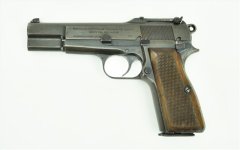Just FYI, wartime BHPs were often sabotaged, the major method being to bypass or mess up the heat treatment, leaving parts, even frames or slides, soft so they would work long enough to pass inspection and proof firing but jam or hang up after only a few shots. (Workers who were caught engaging in sabotage got a different and final view of the front of a gun.)
The distinction between the Browning High Power and the P.640 (b)* is mostly pedantic. The latter was the terminology used by the Germans, but the only real difference was elimination of the magazine safety, and the Germans seized and used the pistols without regard to markings. The standard tangent sight was used on the early occupation pistols, but later dropped for the plain rear sight which had also been used earlier. Pistols in the factory at the time of the occupation might or not have been marked to reflect the new ownership. Standard slide markings were used throughout the war, possibly because FN was actually purchased by a German company.
*The German designation of the BHP in any configuration.
Jim



